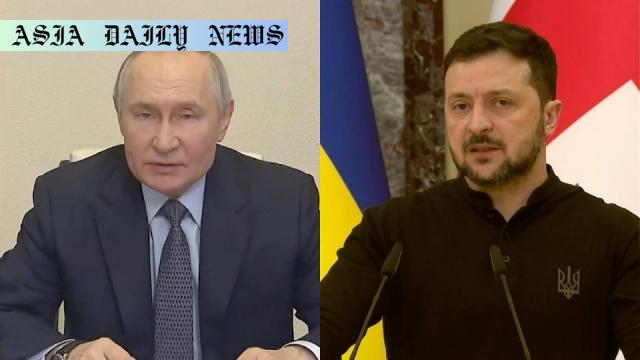Ceasefire: Ukrainian President Volodymyr Zelenskyy accuses Russia of violating the ceasefire despite Putin’s humanitarian declaration.

Introduction: Uneasy Ceasefire Amidst Conflict
Ukraine and Russia have been embroiled in conflict for years, with each passing month bringing new complexities to the situation. Amidst the ongoing hostilities, Russian President Vladimir Putin announced a temporary Easter ceasefire, starting Saturday evening and running through Sunday. The announcement was made under the premise of creating humanitarian respite during the holiday season. However, Ukrainian President Volodymyr Zelenskyy has openly criticized Russia for failing to uphold its own ceasefire commitment, citing multiple instances of aggression.
Allegations of Ceasefire Breaches
In the first six hours of the ceasefire, Ukrainian forces reported 387 cases of shelling, as well as 19 ground assaults by Russian troops. Drones were employed 290 times, raising significant doubts about the sincerity of Russia’s claimed intentions. Zelenskyy noted that while Russia appeared to be staging a façade of peace in some areas, its forces continued attempts to advance in others. The breaches, as reported by Ukraine, suggest that the ceasefire might merely be a strategic distraction, rather than an act of genuine goodwill.
Historical Context: A Pattern Repeating
This is not the first time that Russia has declared a ceasefire only to allegedly violate its terms. A similar situation occurred in January 2023, when a 36-hour ceasefire was declared during Orthodox Christmas. Despite the promise to halt military activities, hostilities persisted, further eroding trust between the two nations. Putin’s latest initiative seems to follow this pattern, leading many to question the real purpose behind such declarations.
Ukraine’s Response and the Call for Extended Ceasefires
Ukraine initially agreed to mirror the Russian ceasefire in kind, with President Zelenskyy proposing an extension beyond Easter. He emphasized the need for more time to establish confidence-building measures, without which true peace is unachievable. However, the continued breaches recorded during even the brief 30-hour truce raise concerns about whether a longer ceasefire could be respected at all. Zelenskyy’s call for extending the truce remains overshadowed by the ongoing aggression.
Analysis: Prospects of Peace Amid Political Gamesmanship
The frequent violations reported during these ceasefires underline the deep mistrust between Ukraine and Russia. Such actions not only diminish the chances of productive diplomacy but also exacerbate the humanitarian toll on civilians caught in the crossfire. While Putin claims to be motivated by humanitarian concerns, the simultaneous military aggression paints a conflicting picture. Both nations face immense pressure—Ukraine to defend its sovereignty and Russia to maintain a position of power on the global stage.
Conclusion: Bridging the Growing Divide
The Easter truce that was intended to foster trust has instead added another layer of strife to an already volatile situation. For any meaningful peace to occur, both sides must implement and respect agreements without resorting to deceptive practices. The world continues to watch as Ukraine seeks to defend its independence, while Russia maneuvers to maintain influence. Until genuine trust is established, temporary ceasefires may only serve to prolong the conflict.
Commentary
The Illusion of Peace During Ceasefires
The notion of a ceasefire is deeply rooted in the hope for temporary respite from the devastation of war. However, the recent claims by Ukrainian President Zelenskyy regarding violations of Russia’s Easter truce highlight its precarious nature. Ceasefires, meant to provide a moment of calm, are instead used as strategic opportunities by some to regroup and gain advantages. This undermines their intent and creates further distrust between nations. When promises of peace are broken almost as soon as they are made, it begs the question: Are ceasefires still valid tools in modern conflict resolution?
The Humanitarian Implications of Broken Ceasefires
From a humanitarian standpoint, broken ceasefires carry severe consequences. Civilians who anticipate relief from violence during these periods often find themselves betrayed, caught in the resurgence of hostility. Lives are lost, infrastructures are damaged, and hope for reconciliation diminishes. More importantly, each violation erodes the public’s faith in the possibility of peace, which can perpetuate a cycle of animosity and retaliation that is difficult to break. The incidents reported during this Easter truce—hundreds of shellings and drone attacks—only reinforce the despair attached to such measures when they fail.
Addressing the Root Causes for Lasting Peace
Ultimately, the failure of temporary ceasefires points to a deeper issue: the lack of trust and a genuine commitment to conflict resolution between the parties involved. Without addressing the underlying causes of conflict— be it territorial disputes, political disagreements, or historical grievances—any ceasefire is likely to be short-lived. Both sides must engage in meaningful dialogue, supported by neutral intermediaries, to establish frameworks for sustained peace. The global community also has a role to play in holding parties accountable for their commitments. Until then, ceasefires may remain symbolic gestures, devoid of real impact.


